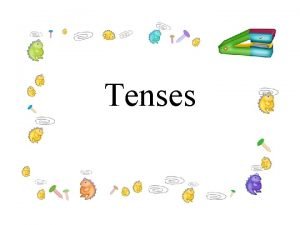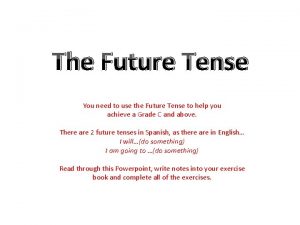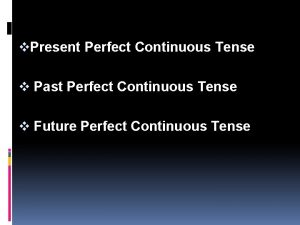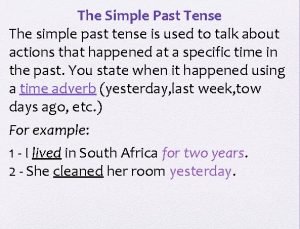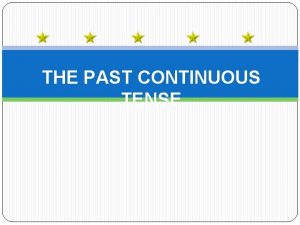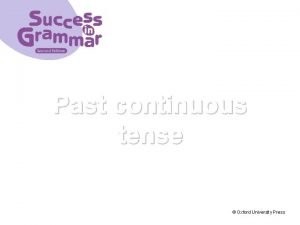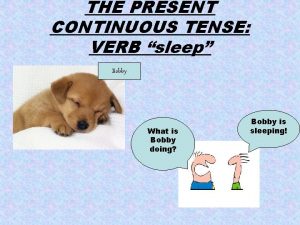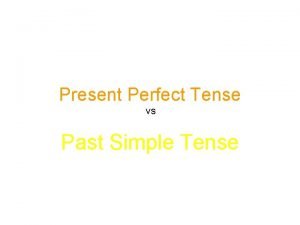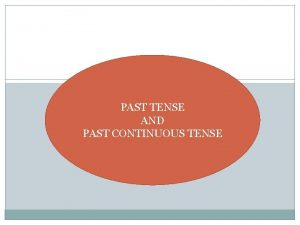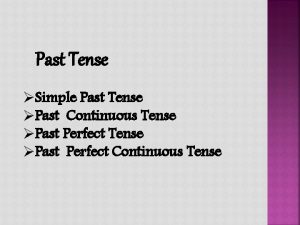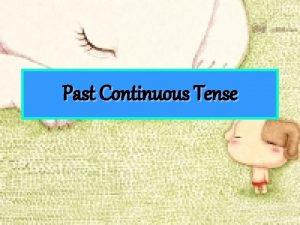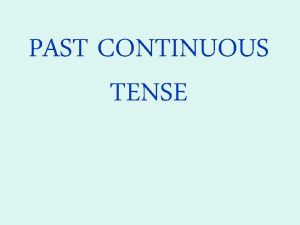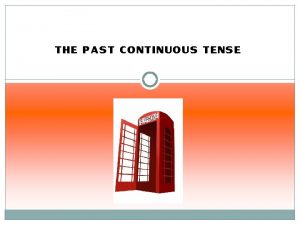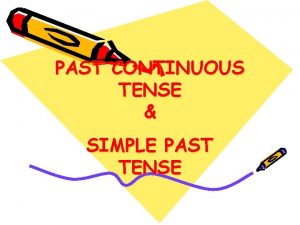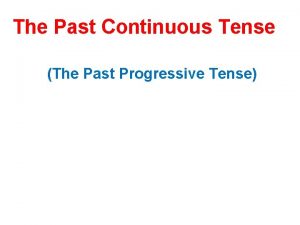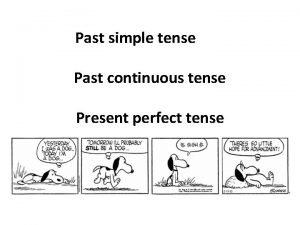PAST CONTINUOUS TENSE Past continuous form The past














- Slides: 14

PAST CONTINUOUS TENSE Past continuous - form. The past continuous of any verb is composed of two parts : the past tense of the verb to be (was/were), and the base of the main verb +ing.

THE STRUCTURE OF THE PAST CONTINUOUS TENSE IS: subj + ect auxiliary verb BE was were + main verb base + ing

For negative sentences in the past continuous tense, we insert not between the auxiliary verb and main verb. For question sentences, we exchange the subject and auxiliary verb. Look at these example sentences with the past continuous tense:

auxiliary verb main verb + I was watching TV. + You were working hard. He, she, was it not helping Mary. - We were not joking. ? Were you subject ? Were they being silly? playing football ?

n The past continuous tense expresses action at a particular moment in the past. The action started before that moment but has not finished at that moment. For example, yesterday I watched a film on TV. The film started at 7 pm and finished at 9 pm.

At 8 pm yesterday, I was watching TV. Past present ------------ 8 pm At 8 pm, I was in the middle of watching TV. future

When we use the past continuous tense, our listener usually knows or understands what time we are talking about. Look at these examples: n I was working at 10 pm last night. n They were not playing football at 9 am this morning. n What were you doing at 10 pm last night? n What were you doing when he arrived? n She was cooking when I telephoned her. n We were having dinner when it started to rain. n Ram went home early because it was snowing. n

We often use the past continuous tense to "set the scene" in stories. We use it to describe the background situation at the moment when the action begins. Often, the story starts with the past continuous tense and then moves into the simple past tense. Here is an example: " James Bond was driving through town. It was raining. The wind was blowing hard. Nobody was walking in the streets. Suddenly, Bond saw the killer in a telephone box. . . "

Past Continuous Tense + Simple Past Tense We often use the past continuous tense with the simple past tense. We use the past continuous tense to express a long action. And we use the simple past tense to express a short action that happens in the middle of the long action. We can join the two ideas with when or while.

In the following example, we have two actions: long action (watching TV), expressed with past continuous tens short action (telephoned), expressed with simple past tense past Long action. I was watching TV at 8 pm ------8 pm---- --You telephoned him Short action. present future

We can join these two actions with when: I was watching TV when you telephoned. (Notice that "when you telephoned" is also a way of defining the time [8 pm]. ) We use: when + short action (simple past tense) while + long action (past continuous tense)

There are four basic combinations: I was walking past the car when I was walking past it. When the car exploded The car exploded I was walking past While the car it exploded. while I was walking past it. it exploded.

n n n Notice that the long action and short action are relative. "Watching TV" took a few hours. "Telephoned" took a few seconds. "Walking past the car" took a few seconds. "Exploded" took a few milliseconds.

SÜLEYMAN ÇINAR EMİRDAĞ ANADOLU ÖĞRETMEN LİSESİ 2003
 Past progressive continuous tense
Past progressive continuous tense Examples of past continuous interrupted
Examples of past continuous interrupted Cut past continuous tense
Cut past continuous tense Head simple past
Head simple past Tenses chart for class 10
Tenses chart for class 10 Future tense to be verb
Future tense to be verb Past perfect y past continuous
Past perfect y past continuous Past simple past continuous or past perfect
Past simple past continuous or past perfect Past simple, past continuous, present perfect
Past simple, past continuous, present perfect Present perfect continuous auxiliary verb
Present perfect continuous auxiliary verb Negative past tense of to be
Negative past tense of to be Was were + v ing
Was were + v ing Past continuous tense questions
Past continuous tense questions Sleep simple present
Sleep simple present Present perfect vs past simple
Present perfect vs past simple



